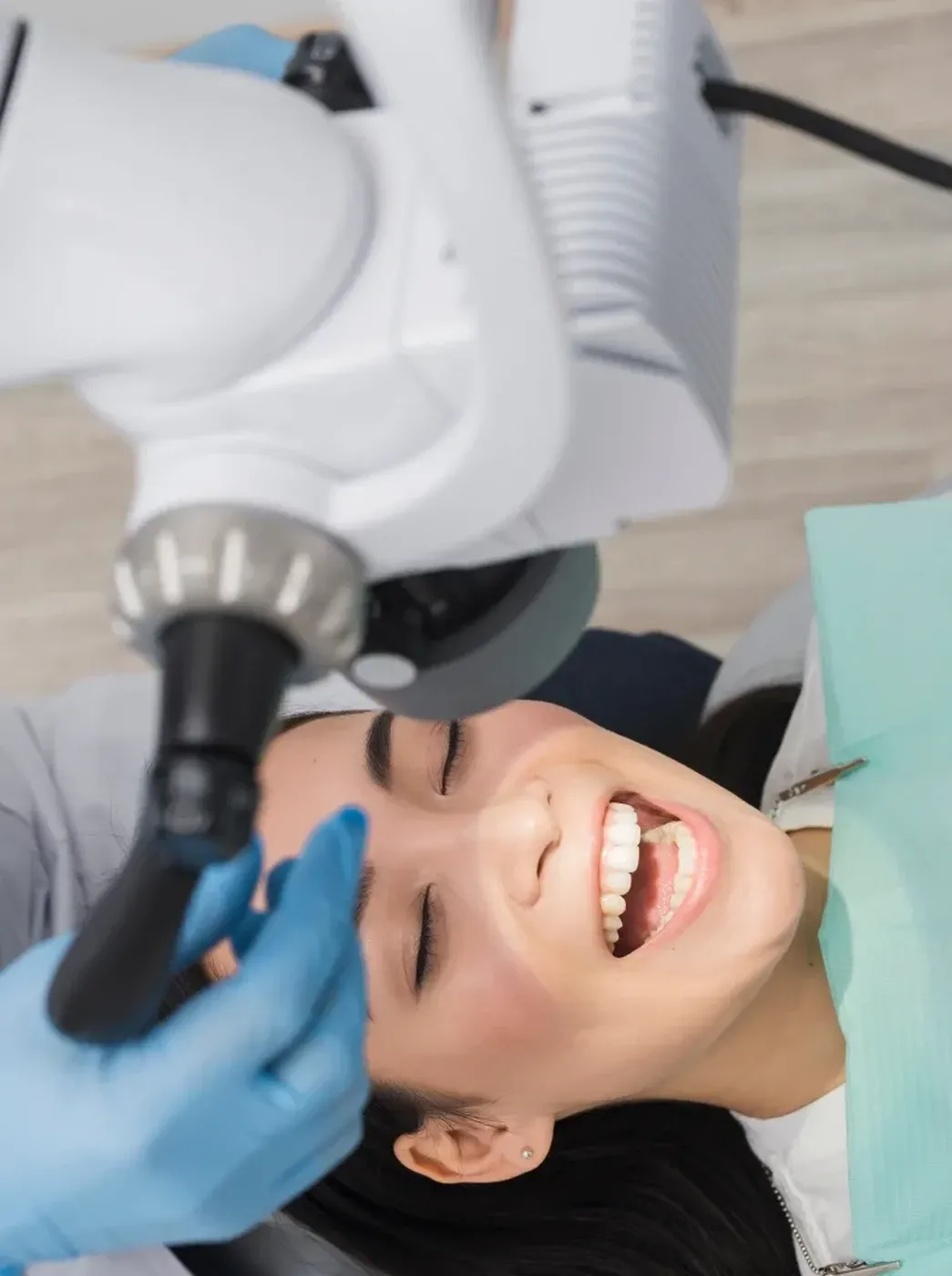
Orthodontic aligners
Aligners are removable trays designed to correct the dental arch. They are made from a transparent polymer material, which is almost invisible inside the mouth. This design is suitable for correcting aesthetic imperfections in cases where the installation of braces is not possible.
Although treatment with aligners is more expensive than traditional braces, the cost is fully justified by the achieved results and convenience in daily use. This method is perfect for mild cases, has practically no contraindications, and provides effective teeth alignment. Aligners are easy to remove when needed, simple to care for, do not injure the gums, and remain inconspicuous to others.
Thanks to modern 3D modeling technologies, an orthodontist can visually demonstrate to the patient the possible treatment results even before starting to wear aligners.
How do teeth straightening aligners work?
The working principle of teeth straightening aligners depends on the individual treatment goal. They are used for the gradual correction of bite or abnormal tooth positioning.
At the initial stage of treatment, the patient is given a set of aligners—transparent trays custom-made according to the shape of the dental arch. They work similarly to braces: applying constant gentle pressure on the teeth, gradually moving them into the correct position and holding them there until the desired result is achieved. For effective results, aligners should be worn at least 20 hours a day.
After the teeth adapt to the first aligner, the patient moves on to the next one in the set. This process is repeated step-by-step until the final result is achieved. The number of aligners needed and the duration of treatment are determined individually by the orthodontist. The orthodontist also periodically evaluates intermediate results and adjusts the treatment plan if necessary.
For adults, it is recommended to wear dental aligners at least 22 hours a day, removing them only during meals or hygiene procedures.
Advantages and disadvantages of aligners
Aligners are a modern tool of orthodontic treatment that allows effective teeth alignment. They have several important advantages:
- Predictability of results. One of the main advantages is clear treatment planning. Thanks to 3D modeling technologies, it is possible to calculate in advance how long the process will take, how many aligners will be needed, and whether additional steps will be required (for example, attachment placement or enamel polishing). The patient sees the expected result before starting therapy, has the opportunity to make adjustments to the plan, and agree on it. Achieving this level of control is more difficult with braces.
- Accuracy of tooth movement. Aligners are made from a special plastic that combines strength and flexibility. Thanks to this, teeth move immediately in the desired direction without the need for additional elements or complex stages, as is often the case with braces.
- Convenience in daily life. Aligners are very comfortable to wear and do not interfere in the oral cavity. Unlike braces, patients can change the aligners themselves according to the markings. If necessary, it is enough to simply send a photo to the doctor for monitoring. Even if one aligner is lost, treatment can be quickly resumed by getting a new one.
- Aesthetics. Aligners are almost invisible during wear. They are hard to notice even up close and can be removed temporarily, for example, for a photo shoot or an important meeting.
- Ease of oral care. Aligners are removed before eating or brushing teeth, so they do not interfere with maintaining full hygiene. This reduces the risk of plaque formation and tooth decay, ensuring the health of teeth during treatment.
Despite all advantages, aligners are not suitable for every case. For complex bite disorders, preliminary correction with braces may be required. However, this need occurs rarely - about 5% of patients. After the initial stage with braces, treatment can be successfully continued using aligners.
What problems can be solved with aligners?
Aligners are a modern and effective orthodontic solution that helps correct a range of dental problems:
- Open bite - when the front or side teeth do not touch, creating a gap. This can cause speech disorders and the impression of a constantly open mouth;
- Crossbite - with displacement of the lower jaw relative to the upper one, the person usually chews on one side, causing discomfort, headaches, and contributing to oral diseases;
- Mesial bite - a situation where the lower teeth protrude noticeably forward;
- Deep bite - the upper incisors significantly overlap the lower ones;
- Crowding of teeth - when teeth are positioned too closely;
- Presence of interdental gaps - including diastema.
Aligners are also an excellent alternative for people allergic to metals and alloys, which makes the use of classic braces impossible.
Contraindications for teeth straightening with aligners
The use of aligners is not recommended in cases where the patient has:
- Presence of dental calculus;
- Destruction of the bone tissue supporting the teeth;
- Periodontitis in the acute stage;
- Congenital jaw development anomalies;
- Dysfunction of the temporomandibular joint (TMJ);
- Severe somatic diseases;
- Impacted (unerupted) teeth.
Some contraindications are relative - they can be eliminated, but the appropriateness and possibility of using aligners for teeth straightening is determined solely by the doctor.
Materials used to make aligners
Aligners can be made from various materials, the most common being silicone and polyurethane. Silicone models are usually recommended for children or used at the final stage of orthodontic treatment - they effectively hold already aligned teeth and are typically worn about 12 hours a day. Polyurethane aligners are custom-made for each patient. They are convenient to remove during meals or oral hygiene.
How does treatment with aligners proceed?
Correcting the bite with aligners involves the individual production of a set of transparent trays for each patient.
Before treatment begins, the orthodontist creates a digital 3D model demonstrating the gradual movement of teeth considering the existing pathology and the patient’s wishes. This model not only visualises the future tooth movement process but also gives the patient a clear idea of the number of aligners needed and the duration of treatment.
Additionally, the patient can see in advance what their smile will look like after treatment completion.
The principle of aligner action is similar to braces: they create controlled pressure on the teeth, guiding them into the correct position. Treatment begins by wearing the first aligner, which applies the least pressure. After the teeth adapt to it, the patient switches to the next aligner with greater pressure. Aligners must be worn at least 22 hours a day. The number of aligners and duration of wearing each are individually determined by the orthodontist for each case.
After finishing all aligners, it is recommended to undergo professional oral hygiene and fix the achieved result with a retainer. It is installed on the inside of the dental arch, making it invisible to others. Usually, the retainer should be worn twice as long as the main course of treatment lasted.
Features of wearing and caring for aligners
During the first consultation, our orthodontists always explain how to properly care for aligners and maintain oral hygiene throughout the treatment period. Transparent aligners require daily cleaning and careful handling to ensure comfortable and effective wear.
Main care rules:
- Daily cleaning. Clean aligners with a soft brush and soap or soapy water. This helps remove food residues and prevents bacteria buildup.
- Do not use hot water. High temperatures can deform the aligners, so it’s better to rinse them with warm or cool water.
- Limit consumption of staining drinks. Coffee, tea, and other beverages can change the color of aligners.
- Remove the aligners during meals. This helps avoid mechanical damage and contamination of the device.
Also, maintain oral hygiene:
- Regular tooth brushing. Brush teeth twice a day and after every meal. If that’s not possible, rinse the mouth with water before putting the aligner back on.
- Proper storage of aligners. When not in use, keep the aligners in a special container to protect them from damage.
- Regular visits to the orthodontist. Check-ups help monitor treatment progress and timely adjust the process.
Proper care of aligners is an extremely important part of successful orthodontic treatment.
What is the price of aligners?
The final cost of aligners depends on the features of the constructions, manufacturer, and materials used. The individual clinical situation of the patient also affects the price. At our Gallant clinic, we select the type of aligners according to your problem and carefully examine the condition of your teeth before starting treatment.
Request a call
We will contact you to schedule a convenient time for your consultation and connect you with the right specialist
Which is better: aligners or braces?
Aligners are more effective than braces when it comes to straightening a segment of teeth or treating crossbite. Aligners (clear trays) work well for mild bite issues and are ideal for patients who cannot frequently visit their orthodontist, whereas braces can handle more complex cases of misalignment under regular supervision (once or twice a month visits to the orthodontist).

Who are aligners not suitable for?
Orthodontic aligners or clear trays for teeth straightening are not used in the following cases:
- complex orthodontic defects;
- severe mental or neurological disorders;
- presence of dental deposits on the enamel;
- acute form of periodontitis;
- presence of unerupted teeth.

What are orthodontic aligners?
This is a modern, discreet, and comfortable method for teeth alignment. Aligners are made from transparent plastic and are custom-fitted to the shape of each patient’s teeth. They provide gradual movement of the teeth into the correct position without the need for traditional braces. Our experienced orthodontists use advanced technologies to manufacture and fit aligners, ensuring comfort and effective treatment.

In what cases are orthodontic aligners used?
- Incorrect tooth positioning
- Malocclusion (incorrect bite)
- Crowding of teeth
- Correction of gaps between teeth



Request a call
We will contact you to schedule a convenient time for your consultation and connect you with the right specialist

Request a call
We’ll get back to you shortly!

Leave a Review
Your feedback means a lot to us!


